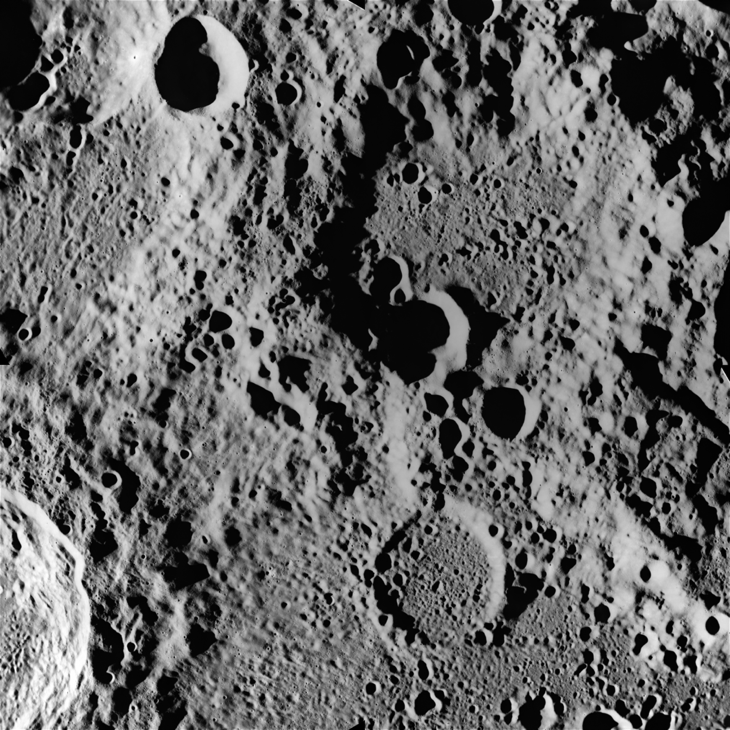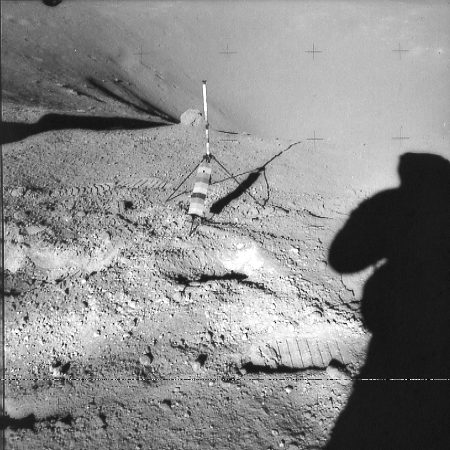
| Project Home | About the Scans | Browse Gallery | Image Map | Support Data | Resources | Ephemeris |
Featured Image - 08/26/2008
Lunar Regolith
The lunar regolith is the blanket of loose dust and broken rocks that covers nearly all of the lunar surface, such as the area seen in Figure 1. It is the lunar regolith that we can see from orbiting spacecraft, and it is the lunar regolith that was directly explored and sampled by the Apollo astronauts. The regolith consists of loosely compacted material formed by repeated fragmentation as a result of impacts. Each time an impact event occurs, the lunar surface is shocked and fragmented. Over billions of years and millions of impacts (most being very small in scale), the material has been so fragmented that the "soil" has become extremely fine grained (on average less than 20 microns in diameter). The lack of an atmosphere and wind prevents these fine particles (sometimes referred to as dust) from being swept away. That is why the footprints left by the Apollo astronauts in the regolith will be preserved if left undisturbed and unimpacted for millions of years or more (see Figure 2).
Figure 1: Portion of Apollo Mapping (Metric) image AS15-M-2211 of a highly cratered area of the surface where the regolith is apparent. You can see hundred of craters of different sizes which illustrates the intensity of the cratering history of the region (see Featured Image: Multiple Generations of Craters on the Lunar Farside). Each impact event fragmented the surface, producing more regolith. [NASA/JSC/Arizona State University]
Touching the regolith material would be very similar to touching the ash and charred leftovers that you would find in your fireplace after burning logs. The regolith is flaky and abrasive like ash, but it is not a uniform size and texture and often contains large chunks of rock. It does, however, pose some challenges that will be overcome by future lunar explorers! The lunar regolith can degrade the operation of unprotected machinery on the lunar surface because it is both abrasive and electrostatically charged, so it clings to nearly everything that it touches. In fact, one of the main concerns of the Apollo astronauts was that they couldn't get all the dust off of their suits after surface activities! However, since we've had almost four decades to think about how to deal with lunar regolith, we have a fairly good idea about how we can overcome its effects on hardware and humans in the lunar environment.
In fact, no matter how "dusty" the surface of the moon is, the regolith will be extremely important to future lunar explorers. Regolith processing will allow future residents of the Moon to more easily extract oxygen from the lunar regolith. This oxygen will be used to create breathable air inside a lunar base and fuel for lunar spacecraft. The lunar regolith can be used to cover a habitat and provide protection from radiation, and it can also be used as an insulating building material. It can even be compacted and cemented enough to be used to make bricks for a large-scale lunar base! The regolith is an easy-to-access resource that will help future lunar explorers to construct and maintain a livable outpost on the Moon. Having such an outpost is essential to long-term scientific experiments and studies that can only be conducted on the Moon!
Figure 2: Apollo 16 70mm Hasselblad image AS16-109-17801 of the lunar regolith. This image shows the astronauts' footprints which will be preserved on the surface for many years. [NASA/LPI]

|
|
Space Exploration Resources |
|
 LPI LPI
|

